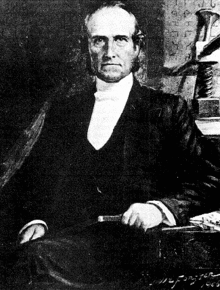James Evans (linguist)

James Evans (January 18, 1801 – November 23, 1846) was an English-Canadian Methodist missionary and amateur linguist. He is best remembered for his creation of the "syllabic" writing system for Ojibwe and Cree, which was later adapted to other languages such as Inuktitut.
Evans was born in Kingston-upon-Hull in England, but emigrated with his parents to Lower Canada in 1822,[1] where he worked as a teacher. He later moved to Rice Lake and continued his teaching work.
In 1833 he was ordained as a Wesleyan (Methodist) minister, and in 1840 he was given authority over the local district in Norway House in Manitoba. During this time Evans did his greatest work - the development of the Ojibwe and Cree scripts. Evans had picked up Ojibwe during his work among the people in Upper Canada. He created the Ojibwe script after first trying to apply a Roman script to their language. Later, he modified syllabics slightly and applied it to Cree, a related language. The scripts were based on Devanagari and Pitman Shorthand. They were easy to learn and led to almost universal literacy among the Canadian Ojibwe and Cree within a few years.
Evans's other missionary work was scarred by turmoil. Evans clashed several times with the Hudson's Bay Company, mostly over their treatment of the native population. Evans accidentally shot and killed his friend and co-worker Thomas Hassall in 1844. He was accused of sexual misconduct with native girls under his care. Although he was acquitted, he was sent to London to defend himself again. The stress took a toll on his health, and he died of a heart attack in 1846.
James Evans's grave was found in England. Then Evans's remains were cremated and sent to Norway House, Manitoba for his final resting place.
Notes
- McLean, John. (1890.) James Evans: Inventor of the Syllabic System of the Cree Language. Toronto, ON: Methodist Mission Rooms.
References
External links
- Biography at the Dictionary of Canadian Biography Online
- The James Evans Collection at the Victoria University Library at the University of Toronto